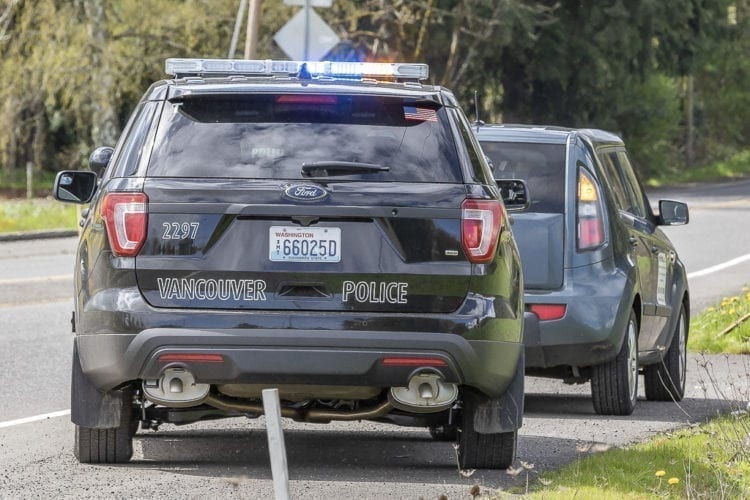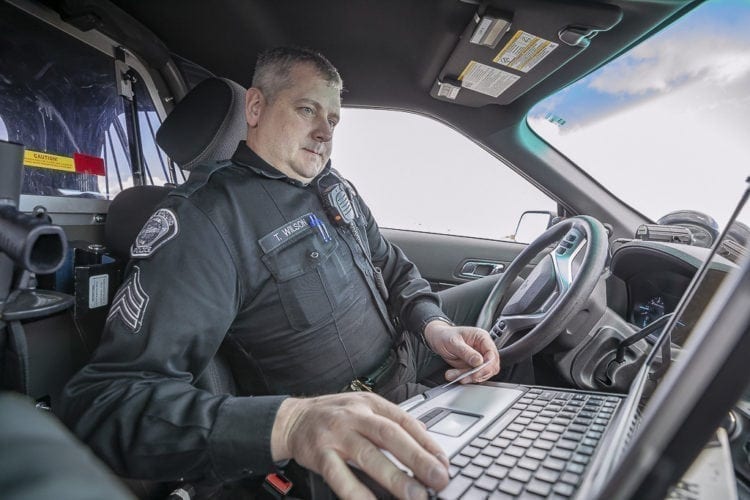Sergeant Tim Wilson of Battle Ground Police let Clark County Today photographer Mike Schultz ride along during a distracted driving sting this month.
The campaign was conducted between April 2-14 by law enforcement across the state
RIDGEFIELD — Flashing lights and sirens were a common sight around Clark County from April 2-14 as a number of local agencies took part in a statewide distracted driving enforcement campaign.
During the 12-day campaign in Clark County, 309 people were pulled over. Out of those, 125 received citations, 230 were warned, and 14 were arrested for other offenses. A first citation under the state’s new E-DUI law (Driving under the influence of electronics) is $136, bumping up to $234 for a second offense. In addition, information about a distracted driving offense is now passed along to your insurance company, possibly meaning an increase in your premium.

“We need to change the culture of distracted driving in our state,” said WTSC Deputy Director Pam Pannkuk. “We believe parents can lead the way in making this shift and model good driving behavior for their children.”
According to one survey, 96 percent of mothers said they believe it’s dangerous to talk on a cell phone, or use an electronic device while driving. But, in that same survey, nearly 70 percent admitted to using an electronic device behind the wheel within the last month.

“I don’t know if it’s just they think that they can drive better than other people,” says Battle Ground Police Sergeant Tim Wilson, “or if it’s just that we have really busy lives that we lead, and we feel like we have to answer that message right away or look at the phone right away.”
The National Highway Traffic Safety Administration (NHTSA) estimates that 3,450 people were killed in accidents caused by distracted driving in 2016 alone. That’s about 10 percent of all deadly vehicle crashes. Also, 391,000 people were hurt in distracted driving-related crashes in 2015 (the most recent year for which data is available).
“Our goal is to raise public awareness about the dangers of distracted driving,” said Hilary Torres, Target Zero Manager for the Clark County Target Zero Task Force. “Research shows that drivers are three times more likely to crash when talking on the phone, and 23 times more likely to crash when entering information into their phone.”
It’s a steep hill to climb, especially amongst younger drivers. Another NHTSA survey found that 20 percent of drivers age 18-20 said they don’t believe texting behind the wheel impairs their ability to drive safely. That number jumps to 30 percent for people age 21-34.
In fact, a study done recently by AAA shows that teenage drivers using a cell phone behind the wheel are as much as eight times more likely to be involved in a crash. Other studies continue to find that the vast majority of people would get upset if they saw someone in another car using their phone behind the wheel, but under the cloak of anonymity most will admit to at least occasionally using their phone while driving.
“We focus on what’s important,” says Sgt. Wilson, “and that’s getting where we’re going safely.”
The new law in Washington allows for a one-tap policy. If your phone is mounted legally, up near the level of your vision, you can tap the screen once. That may be to dismiss a text message, or skip to the next song in your playlist. Holding the phone at all is illegal, or touching it more than once in a short amount of time.

Not just cell phones
While using a hands-free device, such as a bluetooth headset, is still legal, new research shows they also can create hazardous conditions behind the wheel. Research conducted by the National Safety Council concluded that “cognitive drain” while speaking to someone on the phone can cause drivers to miss important visual cues while in traffic. Contrary to popular belief, the human brain is incapable of multi-tasking. In fact, our brains handle information sequentially, switching back and forth between tasks at a high rate of speed. But that means that anything that takes our attention away from the road raises the risk of not seeing the car stopping suddenly in front of us, or the pedestrian trying to cut across traffic.

That research is leading to new concerns about the increasing number of in-dash infotainment systems being installed in newer vehicles. Many use systems such as Android Auto or Apple Car Play, which can read an incoming text out loud and give you the option of voice-dictating a response, or sending an automatic reply to let the person know you’re driving and will contact them as soon as possible. But while many of us learn the layout of our dash by heart fairly quickly, meaning we can change the temperature in the car or switch on the A/C without much thought, the interface on a screen can change with every update. That means we need to spend more mental energy on those simple tasks, potentially leading to distractions that could make driving more hazardous.
And it’s not just cars contributing to the problem. One city in Hawaii recently gained notoriety for making it illegal to be looking at your cell phone while walking on a public sidewalk. Other cities are considering similar rules, as people step out into traffic due to inattention from being on their phones.
The Distracted Driving patrol involved 150 agencies statewide. Locally he Clark County Target Zero Task Force coordinated patrols with Washington State Patrol, police departments from Battle Ground, La Center, Ridgefield, Vancouver, Washougal, Washington State Patrol, and the Clark County Sheriff’s Office with dispatch assistance from Clark Regional Emergency Services Agency.




